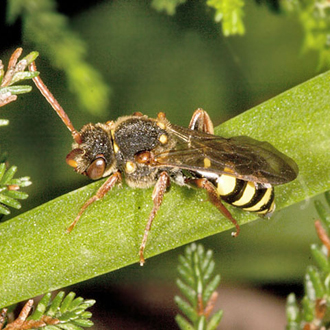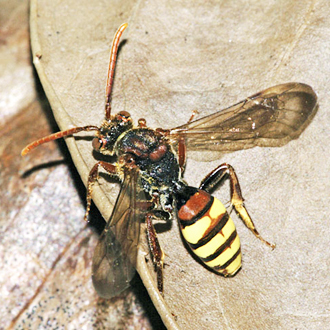

|
 |
 |

|
 |
 |

|
 |

|
|
Judged on their strenuous efforts in finding a suitable location, constructing a burrow (often in hard sand) and providing sufficient pollen as sustenance for their progeny in the nest after hatching, mining bees are models of efficiency and energy. Unfortunately for some, there is no shortage of cleptoparasites able to put a spoke in the operation. Some of these are Diptera such as bee-flies and conopid flies, but there are plenty of cuckoo bees as well, with 16 Sphecodes species preying mainly on Halictinae (Lasioglossum and Halictus), and 28 mainland Nomada bees (four more are found only in the Channel Islands) concentrating on Andreninae. This page focuses on the Nomada crew, a high proportion of which are under pressure across the country, with 11 Red Data Book species and another four that are officially scarce. This even when some of the specific host species appear under no threat. Nomada bees return to a nest as many times as cells are created by the host female. From the resulting egg the first instar of the larva emerges, possessing massive mandibles which enable it to kill the host egg or larva, then feed on the provisions supplied. Succeeding instars have normal-sized mandibles. Three species, notably the rare Nomada signata, are shown in the Gardens section and one (the equally rare Nomada argentata) in the Downland section. There are several others in the Heathland section, including on the Sandpits pages. One of the latter, Nomada fulvicornis, is a Red Data Book species and two others, Nomada baccata and Nomada integra, are scarce. A good number of the remainder can be found in the vicinity of open woodland and hedgerows among other habitats. At first sight many of the genus resemble wasps rather than bees since they carry a combination of black and yellow colouring but two which do not are the tiny Nomada sheppardana (5mm) and slightly larger Nomada fabriciana (7mm). The former is around from May to July and, exceptionally, cleptoparasitises Lasioglossum species. The latter has a longer run, with two broods between March and August, and among its prey is Andrena bicolor. As a point of intetest, Nomada bees come out 'to play' only when the weather is warm enough to tempt the host species out, allowing entrance to temporarily vacant nests for egg-laying. Moving on to the yellow and black species, a number of which have some brown or red markings as well, Nomada leucophthalma is one of the largest at 12mm and also one of the earliest to make its appearance since the principal prey species is Andrena clarkella. The latter is on the wing in March and is quite large, hence the size of Nomada leucophthalma. Members of the genus always have a direct correlation to their prey in that regard and can vary even within one species if different hosts are used. Nomada marshamella (9mm) has two broods and is active from March through to September, preying on quite a wide variety of Andrena bees including Andrena trimmerana. In contrast, Nomada lathburiana (8mm) is a Red Data Book species seen from April to June specialising solely in Andrena cineraria, which is covered in detail on the Bees page. If anything, Nomada lathburiana seems to be increasing in numbers and range, which suggests its status may be secure. The Nomada ruficornis group, also generally seen from April to June, has several related and similar species carrying reddish marks on the thorax. Nomada signata, already mentioned, is one. Nomada ruficornis (10mm) and Nomada flava (11mm) are also from this band. The males of this group are not only smaller than the females, as usual, but are also often hairier with brighter facial markings. The thorax can differ too, and a typical example is the pictured Nomada flava or Nomada panzeri male. These two species are impossible to tell apart even under a microscope, which raises some interesting questions about evolution in this genus. The females of each species, both pictured, are quite readily distinguished. Images © Jeremy Early. All rights reserved. In 2013 I published My Side of the Fence - the Natural History of a Surrey Garden. Details may be found, and orders placed, via this hyperlink My Side of the Fence. In November 2015 Surrey Wildlife Trust published the atlas Soldierflies, their allies and Conopidae of Surrey, jointly written by David Baldock and me. Details are on this web page: Atlas. |